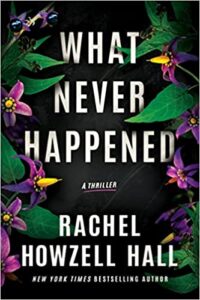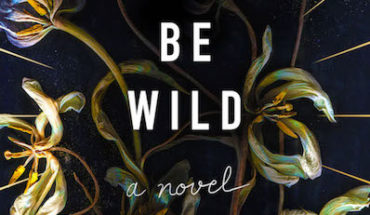 Rachel Howzell Hall’s latest gothic thriller, What Never Happened, has already been making waves as her finest work yet, and it’s no wonder why. Set on Catalina Island, the story follows Coco, the sole survivor of a haunting home invasion two decades ago. She starts investigating a series of suspicious deaths on the island and things take a sinister turn as she receives her own obituary in the mail.
Rachel Howzell Hall’s latest gothic thriller, What Never Happened, has already been making waves as her finest work yet, and it’s no wonder why. Set on Catalina Island, the story follows Coco, the sole survivor of a haunting home invasion two decades ago. She starts investigating a series of suspicious deaths on the island and things take a sinister turn as she receives her own obituary in the mail.
In a recent email conversation Rachel shared the inspirations behind this gripping tale as well as her insights into character development and storytelling. What Never Happened is a testament to Rachel’s exceptional talent for crafting intricate plots and relatable characters.
I want to start out talking about obituaries – both the real and the fake ones that act as death threats – that you incorporate throughout this novel. What made you choose this device, and Collette’s profession of obituary writer? Follow up, what do you think makes a good obituary?
Collette experienced one of the worst events that could ever happen to a person—a home invasion that resulted in the murders of her parents and brother. She knows death. She also knows that victims are more than that. They were fully realized individuals with exciting or mundane lives, who have lived and loved, who deserve more than a tribute that only gives the specifics and offers information that could be used for any other person by simply changing birth and death dates. Her family had those types of obituaries and to her, they didn’t capture the people she cared about.
Because of all this, I chose obituary writer as a career. Good obituary writers do some research, sometimes interviewing those left behind. Good obituary writers learn family secrets and family drama. They are invited guests who get to pry because that’s their job. As I researched this profession, I learned that there are prizes for the best obits written—and reading these tributes… These tributes help you learn more about the decedent, help you see why this person will be missed. These folks are more than birth and death dates. They had ticks and phobias, dreams and obsessions. I think stories that you can’t write without talking to loved ones makes a good obituary.
You also incorporate a lot of text message exchanges throughout this story – some that even act as evidence. How do you approach these versus the other dialogue that you include in the novel? What’s your process on choosing when something would be a text versus a face-to-face exchange?
We do a lot of communicating through text messages now, and so, it just felt right to include them in the story. These ways of communication are different than dialogue because they’re brief, for one. Texts are snippets, misspelled and often direct. They can be bolder than what you say to someone standing in front of you. They’re safe. You don’t have to worry about facial reactions and body language.
So, I chose texts according to the situation. Those times Colette didn’t or couldn’t communicate directly with the recipient.
I appreciated how you included a few very relatable, but not often seen, female relationships that are caring on the surface but hostile underneath. Tell us how you developed these character dynamics. Are they modeled after any experiences you had with friends and family, or imagined?
Ha. Women can be your best friend—and worst enemy. Women have frenemies, friends that you compete against, knowingly or unknowingly. So I had to include those dynamics. I also wanted to tackle the complicated friendships that Black women have with white women. As a Black women with white women friends, it takes me a while to develop a sense of trust. It takes patience to help them see their privilege, their micro-aggressions and biases. You have to determine, as a Black woman, are they an ally or are they the tattletales of the world. You know, the ones who believe they are the world’s manager and have to control everything around them and will rat you out to the boss or to the police because they feel you’ve done something out of bounds.
As for Colette’s relationship with Aunt Gwen… It’s a generational thing, right? Aunt Gwen’s hostile because she is suffering from some mental incapacitation and doesn’t want to admit, but here comes her niece wanting to rule the roost. And there’s also the exhaustion of being an old Black lady who’s fought for everything and watching this young Black woman exist in a world without having to dip her head to white people, to walk in the street to let white folks remain on the sidewalk. To Gwen, Colette has it easy and now, she’s come to take away the house Gwen’s lived in for twenty years? Yeah, she a little hostile.
Catalina, the setting, is a predominately white island undergoing a real estate boom and you depict it in a way that helps highlight the Black experience in America with examples of micro aggressions, police indifference, and blockbusting attempts. Why did you choose to set this story in Catalina and which aspects of the Weber family’s experience with racism were most important for you to include?
I wanted Catalina because of its location—just twenty-six miles or so from California. It’s a part of Los Angeles County but… not. Bad weather comes in, though, and they’re completely cut off by the span of ocean. It’s a spot for the best locked-room story, except it’s an island.
Catalina’s also one of the glamorous places Old Hollywood retreated to, and because of this, the owners of the land and those who managed had to make it more “hospitable” to the rich folks that often visited. That meant displacing the native population there—the Tongva tribe. That meant taking advantage of the fact that Black folks back then weren’t allowed on the ferries that brought people over. And if you can’t cross, then you can’t settle. And so, Black people didn’t have a place there. Even now, there are barely any Black folks living full-time in such a lovely place.
So I wanted to talk about belonging, and how changes in environment can ruin a place. For instance, there’s mention of Colette’s brother eating a tangerine while on the island. The tour guide picks up his discarded seeds from the ground. Well, tangerines aren’t a part of the ecosystem of the island. If a citrus tree grows there, it may take all the water in that area. It may introduce new kinds of bacteria and fungus that are dangerous to native plants. It messes up the balance.
Colette and her family, to some people on the island, messes up the balance.
 You incorporate COVID really naturally in this novel, was that always the plan or did you begin writing it before the pandemic?
You incorporate COVID really naturally in this novel, was that always the plan or did you begin writing it before the pandemic?
Yes, I wanted to include COVID even before I wrote the first page. It was one of the first times in modern history that we had to stay away from each other, for-real-for real, or risk catching the virus and possibly dying. COVID was the apex experience of isolation, even in a city as big as Los Angeles. And then, add the masks—you couldn’t see people, their expressions. You couldn’t determine if that person is a bandit or simply a guy wearing a mask because of the mandate.
So, I wanted true isolation for Colette. I wanted her to be stuck on that island, isolated from what she knows—Los Angeles—for what she’s feared all this time: returning to the place where her family was killed. There was limited ferry runs during COVID, and this cut Colette off even more.
You do a wonderful job making this story terrifying, it’s a page turning thriller! Something I noticed was your use of sound – from window scratches to creaks which often come across as downright sinister because they are so well placed. Can you share your approach to including sensory details in your scenes?
Thank you! Sounds can’t be seen, you know? You rely on your own compendium to figure out what’s making that sound. For Colette, in a place that’s already haunted because of her family, she’s on edge. Her hearing things and not seeing them adds to her fear. She’s also lived in the city all of her life, a place vibrant with too much sound. But those sirens and helicopters and noisy neighbors and car horns become white noise. On an island, you hear the unfamiliar. You don’t know what a deer sounds like when eating, so it freaks you out. You’ve never heard a frog croaking in real life, so that freaks you out. So, as I wrote, I identified those parts of the story that were already suspenseful and used sound to amplify (ha) that.
What’s your advice for young writers just starting out in the horror or thriller genre? Any lessons learned early in your career that you can share?
Read the types of stories you want to write. For fun, initially, and then, a second time, forensically. Learn how the writer built the story, overall, and map out those beats that made the novel successful. Study suspense, thriller and horror screenplays, too. Screenwriters have to get the suspense and horror of a scene in the least amount of words possible.
Rachel Howzell Hall is the New York Times bestselling author of We Lie Here; These Toxic Things; And Now She’s Gone; and They All Fall Down; and, with James Patterson, The Good Sister, which was included in Patterson’s collection The Family Lawyer. A Los Angeles Times Book Prize finalist as well as an Anthony, International Thriller Writers, and Lefty Award nominee, Rachel is also the author of Land of Shadows, Skies of Ash, Trail of Echoes, and City of Saviors in the Detective Elouise Norton series. A past member of the board of directors for Mystery Writers of America, Rachel has been a featured writer on NPR’s acclaimed Crime in the City series and the National Endowment for the Arts weekly podcast; she has also served as a mentor in Pitch Wars and the Association of Writers & Writing Programs. Rachel lives in Los Angeles with her husband and daughter. For more information, visit www.rachelhowzell.com.


1 comment